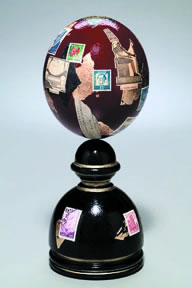
The Society of Architectural Historians – Chicago Chapter invites you to join us for a tour and reception on Saturday, September 29th, 2007.
Dual Subjects: Netsch Design for the U of I at Chicago
Dual Subjects: Netsch Design for the U of I at Chicago
& The 1893 World’s Columbian Exposition Collection at Henry Hall
Hosted by David Sokol and Keith Bringe
The tour kicks off from Henry Hall (click here for printable map), 935 West Harrison \
Hosted by David Sokol and Keith Bringe
The tour kicks off from Henry Hall (click here for printable map), 935 West Harrison \
at 1:00 pm. A reception will follow.
Takamura Ko-un's Ram-ma from the Hooden – or Japanese Pavillion.
Collection: U of I - Department of Art History
RSVP to Keith at 708-358-1394.
Free for members of SAH-Chicago. $10 for non-members.
Take advantage of this special offer; join SAH-Chicago for a full year of great tours, receptions and events at just $25 for individuals and tour for free.
Download this form and bring it with you.
Free for members of SAH-Chicago. $10 for non-members.
Take advantage of this special offer; join SAH-Chicago for a full year of great tours, receptions and events at just $25 for individuals and tour for free.
Download this form and bring it with you.
The tour will include a viewing of the Ram-ma - two monumental carved screens that were featured in the Japanese Pavillion, or Hooden in 1893. This popular and influential feature of the Expo exerted tremendous influence on Frank Lloyd Wright, as well as the community. Unfortunately, these rare surviving 19th century gifts from the Imperial Government of Japan are in terrible condition and are in dire need of conservation and restoration. They were “rediscovered” in the early 1970’s – wrapped in canvas stored under the bleachers at Soldier’s Field. This is an excellent period overview on the Hooden including the Ram-ma. The Ram-ma were positioned at the level of a clerestory and served as ventillation panels.

---------------------------------------------------------------------------------
U of I Tour Part 2: Netsch Campus Design
Walter Netsch original design for the U of I represents a watershed in the history of urban campus design. Netsch was inspired by the idea of a drop of water with waves emanating from a central court - or "forum". The design was visionary and was the first true expression of his Field Theory, but the political circumstances of the University's development and community response have combined to dilute the original vision. We will view surviving buildings and discuss the evolution of the campus. Read Betty Blum's "Chicago Architects Oral History" interview with Netsch (pages 191 - 218).

 The Behavioral Sciences Building expresse a jump forward
The Behavioral Sciences Building expresse a jump forwardin approach to academic form andd function.



No comments:
Post a Comment